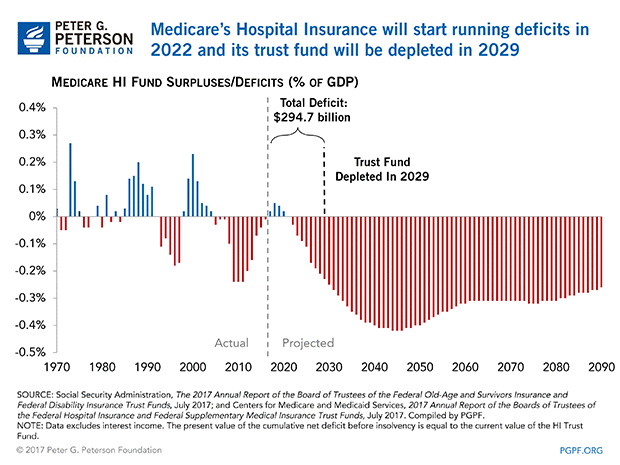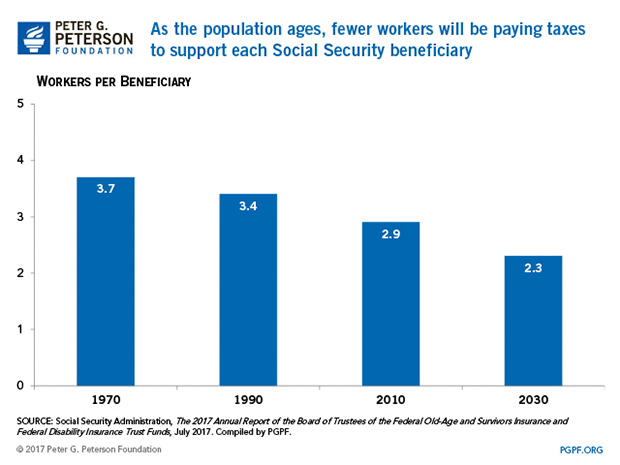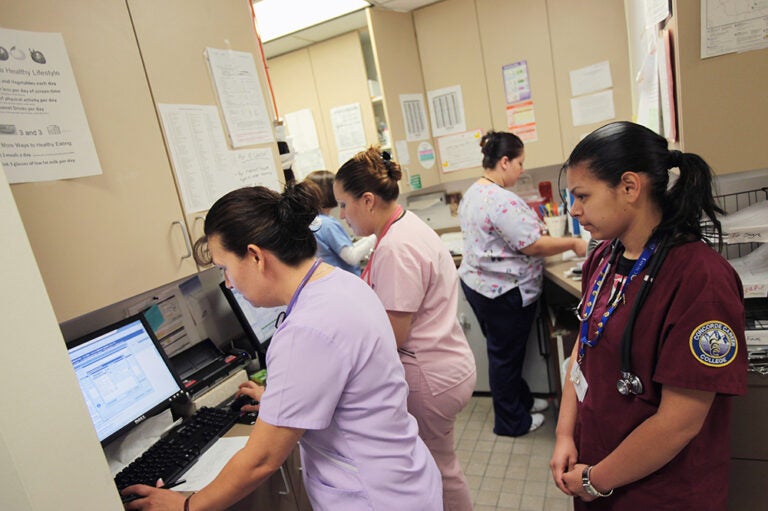Social Security and Medicare affect nearly every American at some point in their lives. Reflecting these programs’ importance, every year the Social Security and Medicare Trustees release a report outlining their financial condition. Unfortunately, the Trustees warn that both programs will face financial shortfalls in coming years. What does all of this mean?
Are Social Security and Medicare Going “Bankrupt”?
No, but both programs are on an unsustainable path. The Trustees warn that predictable demographic trends will cause a significant imbalance between funding coming in, and spending going out in the form of benefits.
- Without action, the combined trust funds for Social Security will be depleted within 17 years.

- The trust fund for the Medicare Hospital Insurance (HI) Trust Fund will be fully depleted in just 12 years.

What happens if the Social Security and Medicare HI Trust Funds are depleted?
- If the Medicare HI Trust Fund is depleted, Medicare will be unable to pay 12 percent of its bills. If this happens, payments to providers, patients, or some combination, would have to be cut.
- If the Social Security trust fund is depleted, all Social Security beneficiaries — 87 million in total — could face across-the-board benefit cuts of 23 percent in 2034.

What Is Causing the Imbalance between Spending and Revenue?
Projected spending growth is driven primarily by two factors: growing numbers of beneficiaries and rising healthcare costs per beneficiary.
The elderly population in the United States is growing rapidly and living longer. In 1990, there were 32 million people ages 65 and older. Today, there are 51 million; within 25 years, the Trustees project there will be 82 million people ages 65 and older.

As the baby boom generation of 76 million people turns 65, enrollment in these programs will balloon. The Trustees project that:
- The Medicare beneficiary population will grow from 59 million in 2017 to 78 million in 2028 — an increase of more than 30 percent.
- Social Security beneficiaries will reach 87 million in 2034 – an increase of more than 41 percent.
Americans have also been living longer, which increases the length of time that people receive benefits from the program. In 1970, the average 65-year-old male was expected to live until age 79; today, he is expected to live until 84. The comparable life expectancies for women are 84 in 1970 and 87 today. While this is a welcome trend, it means that recipients will receive benefits for longer than they have in the past.
At the same time, as the population ages, fewer workers will be paying taxes to support each beneficiary, creating an imbalance between projected spending and revenues.

In addition to these demographic factors, the average cost of healthcare for Medicare beneficiaries is growing, and has been growing for more than four decades. In fact, the average cost per Medicare beneficiary (after adjusting for overall inflation) has more than tripled over the last forty years: the annual cost is now approximately $13,000 per beneficiary.

Is There a Way to Fix the Problem?
The good news is that many policy solutions are available to address these predictable challenges and improve the financial outlook of Social Security and Medicare — solutions that have been proposed and supported by members of both parties through the years:
- The Congressional Budget Office has published a report containing thirty options for improving the long-term stability of Social Security. Examples of reforms include: reducing annual cost of living adjustments, increasing payroll taxes, lifting the income cap on payroll taxes, reducing initial benefits, and raising the retirement age.
- The Bipartisan Policy Center also published a major report outlining options for strengthening both Social Security and overall retirement security, as well as a report on containing healthcare costs.
You can try your own hand at fixing Social Security with this online tool from the Committee for a Responsible Federal Budget, which allows you to select from various policy options.
Why Act Now?
Importantly, if policymakers act sooner rather than later, they will have more and better options, which can be gradually implemented to reduce the impact on current and future beneficiaries. Conversely, every year of delay and inaction limits options and makes reform more difficult, which will require larger benefit cuts, higher taxes, or both.
Want to Learn More?
Read our full analyses of the Social Security Trustees report and the Medicare Trustees report.
Image credit: Photo by zimmytws/Getty Images/iStockphoto
Further Reading
Budget Basics: Unemployment Insurance Explained
The Unemployment Insurance program is a key counter-cyclical tool to help stabilize the economy and speed recovery during downturns or crises.
Quiz: How Much Do You Know About Healthcare in the United States?
The United States has one of the largest and most complex healthcare systems in the world. Take our healthcare quiz to see how much you know about the cost and quality of the U.S. healthcare system.
How Did the One Big Beautiful Bill Act Change Healthcare Policy?
The OBBBA adds significantly to the nation’s debt, but its healthcare provisions lessen that impact by $1.0 trillion.


